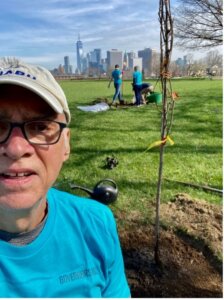C2ES staff not only does groundbreaking research on cutting greenhouse gases and climate change, we walk the walk, too!
Our team members are sharing our own sustainable living tips on Earth Day, 2022
Use your feet!
Stephanie Gagnon, Associate Policy Fellow
I combine carbon-free trips for exercise and errands. Many of us learned how to appreciate a good walk or bike ride during the pandemic, and by going a little farther for your workout, you’re going a lot further to save the planet!
Consider whether your exercise route could take you to someplace you normally go by car. I’ve started combining afternoon walks with trips to my local library, or weekend bike rides with quick grocery trips to grab those last necessities for dinner. It gives me some purpose in my route choice and cuts my gasoline bill!
Save packaging to reuse later—Plenty of grocery essentials come in packaging that can be rinsed, relieved of its label, and reused! Consider uses for glass mason jars from pasta sauce to propagate plant cuttings, transport leftovers to the office for lunch, store pencils and pens, or even preserve veggies from the garden for winter. Store-bought salad dressing bottles make great storage containers for leftover condensed milk, maple syrup, homemade face/hair masks (another plastic-free alternative!), and even art supplies. Just make sure you consider your storage plan or you may have some annoyed roommates alongside your container collection.
“Less meat” doesn’t mean no meat
Philip Horowitz, Communications Associate
I have worked to reduce my individual impact by consuming less meat. Agriculture accounted for 11 percent of all U.S. emissions in 2020, up from 10 percent in 2019. These emissions originate across the supply chain, from manure manufacturing, the transport of animal products, changes to the landscape for pasture, and even the methane resulting from animal rearing. Because these emissions are so widespread, they are very difficult to avoid. Further, while I have tried to get on board with being plant-based and vegetarian and vegan, there is something about a well-roasted chicken or a bento box of sushi that I am not willing to give up.
What do I mean when I say I aim to consume less meat? Exactly that. Climate change is a systems-wide problem that I cannot change with individual actions, but I can focus on reducing my net-impact. I can’t stop eating cheese, but I don’t mind using a milk alternative in my coffee. In making my meal decisions, I can focus on ingredients that have the least impact: substituting steak or pork for chicken or fish (or even tofu, seitan, or beans).
Making these simple choices consistently but not always (steak au poivre, anyone?)—and encouraging your friends and family to join in—sends market signals that consumers are interested in and willing to pay for lower-carbon options when it comes to their dining choices. It might not seem like much, but even these choices can make a difference.
Consider what you need
Christina Cilento, Associate Policy Fellow
I’d like to give an important reminder that you don’t need to buy anything to live more sustainably! Any budget can accommodate easy switches like taking shorter showers, buying second-hand clothing, and not wasting food, and, in fact, many of these actions will actually save you money. One of the best ways to be more climate-friendly is to only buy what you truly need.
Also think compost bins – this article has a great rundown of how to choose the right composting system for your home: https://learn.eartheasy.com/guides/how-to-choose-the-right-composter/
Buses, trains, not automobiles
Marty Niland, Senior Communications Manager
I use public transit for long daily commutes. Back to the office means back to the bus and subway for many of us who live 20 or more miles from work. Transportation is still the top source of U.S. emissions, and by choosing not to drive to work every day, I’m avoiding emissions and saving money.
Using a commuter bus and the Washington area’s Metrorail instead of my car for my 56-mile round trip saves 14.4 metric tons of carbon dioxide equivalent a year, according to Carbon Footprint’s Carbon Calculator. That’s as much as 17 acres of forests would sequester in the same time, according to the EPA Greenhouse Gas Equivalencies Calculator, or about the same energy savings as switching 546 incandescent bulbs to LED’s. Ask your employer about pre-tax transit benefits, which reward you every paycheck for such a sustainable choice.
Teamwork makes the dream work
Bob Perciasepe, Senior Adviser
We often think of living more sustainably as a set of personal action commitments. Personal commitments are essential and that should also extend to doing work in your community.
I volunteer to care for trees in parks in and near my neighborhood. While this isn’t going to solve the climate crisis, it is going to help stabilize urban tree canopies and their carbon sequestering action. If we lose the existing urban canopy it will only make things worse.
Careful work to make sure there will be replacements already growing as older trees reach the end of their life and expand the canopy where possible is a key strategy. City trees also help on the resilience side, providing shade against extreme heat and green infrastructure benefits from intense rain. Helping neighborhood trees and planting new ones is something almost everyone can do.

Bob Perciasepe at the spring planting of Sweet Gum, Oaks and Maples on Governors Island in the New York Harbor
April 2022
